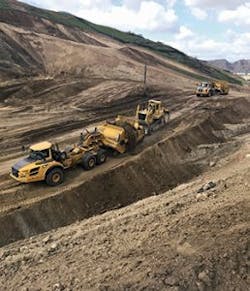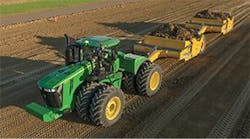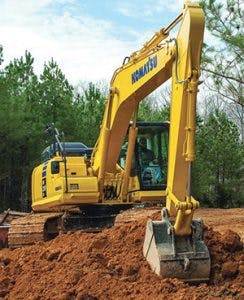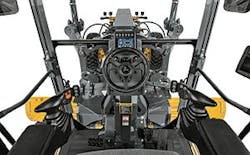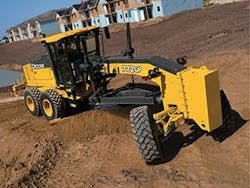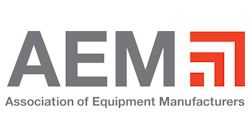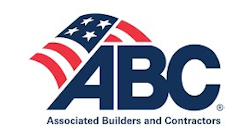Tight deadlines and tighter margins, combined with a shortage of skilled operators, have made the addition of advanced technology for heavy equipment such as scrapers and motor graders crucial.
It takes a long time to learn how to operate a grader. “It’s difficult to find skilled operators who are efficient, understand the job site, and know how to operate a motor grader,” says Luke Kurth, product marketing manager for motor graders at John Deere. “It takes a long time to learn how to operate a grader.”
A motor grader is a fine precision tool, proclaims Tony Piraino, market development engineer, Caterpillar. Technology makes it easier for the novice—a benefit particularly when contractors are having so much trouble getting new and experienced operators.
A change in the industry a few years ago took most of the experienced operators out, and Kurth explains while the economy is “coming back quickly,” the operators aren’t. Because there are not enough operators to keep up with the demand, he believes it’s important contractors have the right machine to both attract experienced operators and assist inexperienced ones.
Equip the guys with the technology to overcome their lack of experience, Piraino advises. “Even the experienced operators see the benefit of efficiency and doing a better job more quickly. You can’t eyeball to this level of accuracy.”
A K-Tec A40F leads the way
Smooth Operator
An effective operator makes a difference for a company, says Shane Kroeker, marketing manager, K-Tec Earthmovers. But, he adds, previously in the industry it’s been hard to find quality operators. “It’s a complex task in an environment that is ergonomically uncomfortable.”
Because of the shortage of operators, there is more of a focus on the operator when it comes to design. An operator has more say in the machine now. “We try to make the machines easier to use,” says Kroeker. That includes offering onsite-training included in the purchase price.
Deere incorporates ongoing training through JDLink—a telematic monitoring system that watches for fault codes and for when operators use different functions such as auto shift and auto diff in order to later train them if they aren’t already using them.
It’s all about an operator’s choice, says Kurth. Comfort and familiarity comprise a significant portion of that choice. Deere offers three different types of controls, including a new dual joystick option, which is intuitive—especially for millennials accustomed to gaming—and based on the traditional control pattern. Operators don’t need to re-learn how to run a grader. An inexperienced operator can quickly learn to cut the basic controls within hours.
Joysticks allow an operator to keep his hands on all the controls because Caterpillar added advance control and additional functions to their joystick. Their Advanced Control joysticks boost operator safety, efficiency, and productivity and are easy to learn and use. It’s also easier on the operator, Piraino says, enabling him to do a better job.
The John Deere 9620R with pull-type scrapers
The controls let operators steer, shift, articulate, adjust the blade, use automated grading systems, and control auxiliary hydraulics, all without taking their hands off the joystick. An exclusive feature allows up to nine frequently-used cross slope favorites to be saved and returned to in an instant for quick transitions between grades.
Alternatively, armrest-mounted fingertip controls with lever steering are an option. Kurth says it can be more comfortable, allowing the operator to sit back in the seat and thereby removing fatigue to boost efficiency.
The traditional antler rack is still available. “Most seasoned operators learned on this style,” notes Kurth. And, of course, regardless of what type of control pattern is chosen, there’s always a steering wheel on every Deere grader, which is good for driving back quickly at the end of the day. It’s all about whatever the operator likes better and improves productivity to help him get to grade more quickly with fewer passes.
Deere graders have the productivity-enhancing features and options built into them. Auto shift and auto diff lock eliminate the risk of damaging critical components and automatically engage on the fly to shift when needed into higher loading gears or engage the diff lock to gain traction. Auto shift and auto diff lock eliminate the risk of damaging the machine. Deere’s 6-wheel drive models provide 30% more pulling power. Because they have one-third more pull, they can pull through cuts and turns more easily. There’s no fighting the machine.
Grade Pro models offer return-to-straight, which automatically returns rear articulation to center with the push of a button. Kurth says all Deere graders have the highest horsepower and torque in their size classes.
Both new and experienced operators benefit from AutoLoad, an industry exclusive for Deere, says Maryanne Graves, product marketing manager for scraper systems. It enables consistent and fast loading with the capability to pre-set the ground level for the blade. There are three blade positions: upper for loading, lower for cutting, and ground level. “You get consistent cut and spreading.”
A tutorial in the monitor coaches inexperienced operators on how to use the AutoLoad function. The tutorial tells the operator which position to put it in and walks him through the steps for each application. “The interface makes operators more proficient,” continues Graves. “New operators don’t necessarily have a good feel for when they’re in the cut; this allows them to do the work without thinking about it. It makes them consistent.”
Because fuel is costly, an efficiency manager adjusts and matches the performance of the engine and transmission to the ground speed. “It uses the lowest rpm to maintain ground speed,” indicates Kurth. Doing so lowers owner and operator costs and saves fuel.
Some customers run a single pan, some a double, but a lot run a triple pan—carrying 72 cubic yards of material. Visibility is important no matter how many pans an operator runs. Deere’s CommandView III cab allows an operator to rotate 40 degrees in the seat in order to see the pans clearly. A high-resolution display and a command arm that controls all functions add to the comfort and efficiency.
Precision digging with the Komatsu PC210LC-11
Regardless of the number of pans, an accurate cut with minimal overlaps is important. Active command steering helps hold the tractor and the pan in line without any corrections, without fishtailing. “It holds the steering straight,” sums up Graves. “It’s an efficient way of moving dirt.”
In Control
“Control what you can and manage the rest,” recommends Piraino. To assist with both, Caterpillar offers a suite of technologies for all M Series, M Series 2, and M Series 3 models that includes Cat GRADE with Cross Slope, Stable Blade, Auto Articulation, and Advanced Control Joysticks.
Cat GRADE with Cross Slope helps operators improve accuracy and get to grade faster. A simple two-dimensional system automatically adjusts the slope of the blade, based on manual input on the other side, to instantly produce a uniform cross slope across the road surface.
“This system will help any operator—from the new hire to the veteran—work quickly and precisely using less fuel and materials,” says Piraino. “The government performed studies comparing fuel savings and material savings.”
The eight-month production study that supports his statement was completed in 2013. Several machines were used to build a road—some with cross slope and some without. The results indicated that the machine using cross slope was more accurate (2% off target cross slope versus 28%), used an estimated 422 gallons less fuel due to fewer passes required, and required 40% less material to achieve a consistent road construction.
Instead of “eyeballing it” or using grade stakes, Piraino says that sensors detect the incline if the blade is turned. Set a target and it maintains consistent cross slope by raising both sides of the blade and adapting to the road. Favorite cross slopes can even be stored as pre-sets—a Caterpillar exclusive.
Grade Pro—John Deere’s version of cross-slope for GP graders—allows the operator to hold the slope. “They just dial in with the monitor and can run it with one hand,” states Kroeker.
Cross slope is just an entry point, Piraino believes. For finer precision, he suggests adding three-dimensional GPS and total station. Although the 2D system does not require satellites or infrastructure, a more advanced 3D system makes use of a satellite system and GPS. “You can have a base station on site to create a plan digitally.” It knows where you’re at and can change the elevation. Otherwise, you have to rely on grade stakes, grade checkers, and the operator’s skill—which can be off between the stakes.
Tolerances are tight. If an operator is even just a little off, he may need to add fill material, which costs money. “If you undercut the base, you need a lot of extra money and time,” observes Piraino. Doing so also affects the cost of contracts. “If you check for accuracy, and for the thickness of the subsurface against the tolerances, you can earn bonuses.” Ultimately, the value of cross-slope is a longer-lasting surface.
Precision is key. Inexperienced operators may not detect or not know how to respond to machine bounce. If they don’t, the result is a washboard effect on the road surface. Stable Blade is Caterpillar’s industry-exclusive, first-of-its-kind, patented technology that detects machine bounce even before the operator can feel it and automatically reduces machine speed to stabilize the motor grader without the need for operator intervention. Once stabilized, the machine will return to original speed, again with no operator input required.
“Stable Blade detects bounce before the operator feels it,” claims Piraino. It then slows the motor grader in order to avoid putting in divets—like a washboard—and damaging the road surface. Eliminating the need for road surface rework can lower fuel consumption by up to 14% while reducing motor grader wear and tear.
It proactively manages the operation and prevents damage from occurring in the first place, allowing operators to concentrate more on maintaining a smoothly graded surface and less on predicting their next bounce. “It’s easy to get into a bounce situation due to the distance between the tires and the mull board. If you hit a bump, it will bounce.”
Not only does Stable Blade save wear and tear on the machine, but it also extends the life of the roadway by producing a consistent, smooth finish.
Another way to improve performance is to increase maneuverability in tight space with auto articulation that automatically articulates the motor grader during steering. “The machine bends in the middle if you command it,” explains Piraino, enabling operators to make tighter turns for cul-de-sacs and intersections. It reduces operator fatigue because they don’t have to steer and articulate separately, and it improves productivity—particularly on sites with curves, turnarounds, and other obstacles. In addition, auto articulation reduces the learning curve for new operators and makes them look like experienced operators by performing two simultaneous commands with one input, Piraino concludes.
Inside a John Deere motor grader cab
Productivity
Whether it’s getting to grade faster or hauling more material, productivity is the goal. Many factors contribute to productivity, from operator comfort to electronic technology. K-Tec’s automated load control is easily visible on the operator’s display screen; it refines automatic load count and allows the operator to see the record of the number of loads completed. It also provides service reminders for scheduled intervals, daily greasing, tire pressures, and more.
K-Tec machines are Trimble GPS-ready from the factory, but some technology comes straight from the factory. “We have three core technologies built in,” lists Kroeker. Load Tec is a hitching system that distributes the load weight of a full scraper for better balance and better pull: 75% on the scraper’s axle, 25% on the tractor’s. Tensile Tec involves high-tensile plate steel at high stress. “The goal is lightweight, strong structural stability.” Lube Tec means fewer grease points, one-minute grease points, and greaseless bushings for less time spent on maintenance.
Additional features include an automatic cushion ride function with a shock absorber for a smoother ride. “You can travel faster on the haul roads and complete more cycles,” says Kroeker. This feature also limits wear and tear. Their pull grader land leveler helps maintain haul roads and get to finish grade, while a drag box picks up high levels and fills in low levels, allowing an operator to get to a fine millimeter.
Getting to grade faster is important, but how it’s accomplished can vary. John Deere integrates with almost any grade control system through open architecture.
A John Deere 772GP makes a turn
Versatility and options are conducive to increased productivity. Deere offers tire and track machines (two- and four-track), as well as injector and carry-all options. “Contractors can choose the configuration that works best,” says Graves. “That makes things easier.”
While tires and an injector pan are the most popular options typically, the choice depends on the site, Kurth interjects. On the machine body, tires work best in top soil, clay, and gumbo. Track is better when conditions are less soft underfoot. On the pan, a carry-all is the better option for topsoil because it sheds and spreads easily, while an injector is better suited to push stickier material. If you have multiple applications, he adds, “work with the softest option.”
Productivity and efficiency go hand-in-hand. Deere’s Eco Mode promotes fuel efficiency by reducing fuel consumption by 5–10%. It works by eliminating the highest revolutions per minute. “You don’t need road speeds for grading,” says Kurth. By limiting the top revolutions per minute, the machine is able to run in a more efficient place on the engine for fuel savings.
Those aren’t the only savings to be had. Compared with traditional earth-moving equipment, Graves estimates this at one-third of the initial investment, with half the labor (because it requires only one operator). “It is 50 cents per cubic yard of material cheaper when moving.”
“Our scrapers have always had a lot of technical advances—such as self-loading machines, cutting edge angles, and bold dimensions. Technology is in our name,” says Kroeker proudly. “We were the pioneer, introducing the first ADT scraper at ConExpo in 2008.” They converted an articulated dump truck into a scraper and by doing so, it showed contractors that they could use their existing fleet of trucks.
Advantages include the fact that the conversion is familiar; the driver already knows the machine, so the learning curve is brief. Whether it’s a converted machine or a machine that mimics features found in other vehicles, that familiarity can play a significant role. That’s why Caterpillar looks at industry technical trends beyond the motor grader. “People drive to work in trucks,” notes Piraino. “If they’re used to features in them, they adapt to them on the grader. There’s still a learning curve, but it’s shorter.”
A simple example of a familiar design is facing the operator forward in a comfortable cab. K-Tec even added a joystick and padded arm, as well as an operator display system. Another benefit of the conversion is that it is completely reversible because it uses bolt-in components.
The beauty of cutting-edge technology is that it can make an inexperienced operator proficient, but even the best operators can benefit from it.
